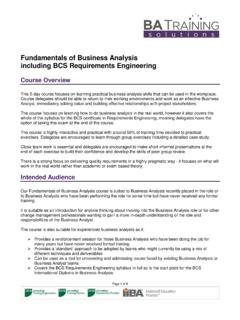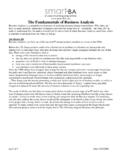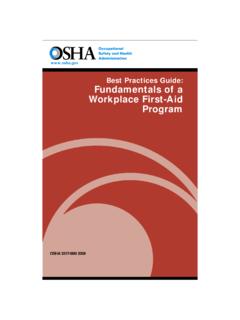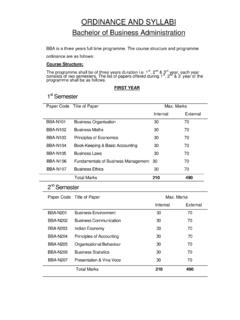Transcription of VOLUME I: Fundamentals & Ingredients BAKING …
1 VOLUME I: Fundamentals & Ingredients FOURTH EDITION. BAKING . VOLUME I: Fundamentals & Ingredients Pyler and Gorton Fourth Edition BAKING Science & Technology Science & Technology PYLER. AND GORTON. SOSLAND PUBLISHING COMPANY. ii /. Copyright 2008 by Sosland Publishing Company. All rights reserved. Library of Congress Control Number: 2008934285. ISBN 978-0-9820239-0-7 BAKING Science and Technology, VOLUME 1. ISBN 978-0-9820239-2-1 BAKING Science and Technology, 2 VOLUME Set No part of this work may be reproduced or transmitted in any form or by any means, electronic, mechanical, or graphic, including photocopying, taping, or recording, or by any information storage or retrieval system without the prior written permission of Sosland Publishing Company unless such copying is expressly permitted by federal law.
2 Printed in the United States of America Sosland Publishing Co. 4800 Main St., Suite 100. Kansas City, MO 64112. Telephone: (+1) 816 756 1000. Fax: (+1) 816 756 0494. Web: Every effort has been made to ascertain the owners of copyrights for the selections used in this VOLUME and to credit and/or obtain permission to reprint copyrighted information and graphics. Sosland Publishing Co. expresses its gratitude for permissions it has received. Sosland Publishing Co. will be pleased, in subsequent editions, to correct any inadvertent errors or omissions that may be pointed out.
3 BAKING Science & Technology / iii Foreword BAKING Science & Technology, 3rd edition stayed in print for nearly 20 years, but as the industry approached the 2007 International BAKING Industry Exposition, it became clear that a new edition was needed. Much had happened, especially on the nutrition side as well as with process automation, and the industry now encompassed many new aspects not covered in the text. The 4th edition was announced at that international trade show, and this book is the first of two volumes comprising the new version.
4 BAKING Science & Technology, was first published in 1952, then again in 1972 and 1988. That this book stood the test of time and continues to be used as a textbook by the industry's leading BAKING schools and as a daily reference for thousands of bakers worldwide is testament to its original writer's insight and writing ability. For the 4th edition, Sosland Publishing approached Laurie Gorton, executive editor of BAKING & Snack. She has nearly 35 years experience covering the technical, scientific and business aspects of the grain-based foods industry.
5 The grain-based foods industry and BAKING in particular face as many, if not more, challenges than 20 years ago. Today's issues involve nutritional content, food safety and the demands of the health-and-wellness shopper. But every era brings its own concerns to the table, quite literally. We intend BAKING Science & Technology to move into the future through this new edition and, later, digital formats. As developments occur, the book will be updated using emerging electronic technologies. We encourage readers to comment on this edition and its contents and to recommend topics and changes for future inclusion.
6 Mark Sabo President, Sosland Publishing Co. August 2008. BAKING Science & Technology / vii Table of Contents Foreword .. ii Chapter 1: Basic Food Science .. 1. Carbohydrates .. 2. Sources of carbohydrates used in BAKING .. 2. Carbohydrate synthesis .. 2. Simple vs. 3. Physical and chemical 4. Monosaccharides .. 4. Sugar: Disaccharides and 5. Starch .. 7. Dextrins .. 11. Gelatinization of starches .. 12. Retrogradation of starch .. 14. Acrylamide formation .. 15. Glycemic index vs. glycemic 16. Pentosans.
7 17. Sources of pentosans in BAKING .. 17. Structure .. 18. Physical and chemical 18. Functions and effects during BAKING .. 18. Fiber .. 20. Sources of fiber .. 21. Definition of dietary fiber .. 21. Structure .. 26. Properties of fiber in food .. 27. Probiotics, prebiotics and synbiotics .. 27. Proteins and enzymes .. 28. Proteins .. 29. Sources of proteins .. 30. Amino acids .. 31. Classification of proteins .. 34. Structure of proteins .. 39. Properties of proteins .. 41. Proteins of wheat .. 43. Enzymes.
8 47. Sources of enzymes .. 47. Classification and nomenclature of enzymes .. 49. Lock-and-key, induced fit of enzymes .. 51. viii / Table of Contents Properties of 51. Lipids .. 55. Source of lipids .. 55. Nomenclature .. 56. Chemical composition .. 57. Fatty acids .. 57. Fatty acid naming protocols .. 58. Saturated vs. unsaturated .. 58. Cis vs. trans .. 62. Short- and medium-chain fatty acids .. 63. Mono-, di- and triglycerides .. 63. Sterols and stanols .. 64. Other lipids .. 64. Physical aspects .. 64.
9 Liquid, plastic and solid forms .. 64. Melting point .. 65. Crystallinity .. 66. Hydrogenation and interesterification .. 66. Oxidation .. 68. Autoxidation mechanism .. 68. Antioxidants .. 69. Hydrolysis and 70. Physical chemistry .. 71. Acid-base reactions .. 71. Electrolytes .. 71. Titration .. 72. Active acidity .. 73. The pH 74. Buffers .. 75. pH determination .. 76. Role of pH in BAKING .. 77. Buffering action of proteins .. 78. pH in chemically leavened product .. 79. Oxidation and reduction .. 80.
10 The redox potential .. 81. Estimation of redox potential .. 81. Role of oxidation in BAKING .. 82. Role of pentosans .. 83. Role of thiols and disulfides .. 84. Role of flour lipids .. 85. Dough physics: colloids and rheology .. 86. States of matter .. 87. BAKING Science & Technology / ix Molecular forces .. 88. Colloidal 89. Emulsions .. 90. 92. Colloidal character of dough .. 92. Colloidal aspects of flour particles .. 93. Starch .. 94. Dextrins .. 96. Pentosans .. 96. Water 97. Flour 97. Role of polar flour 98.









